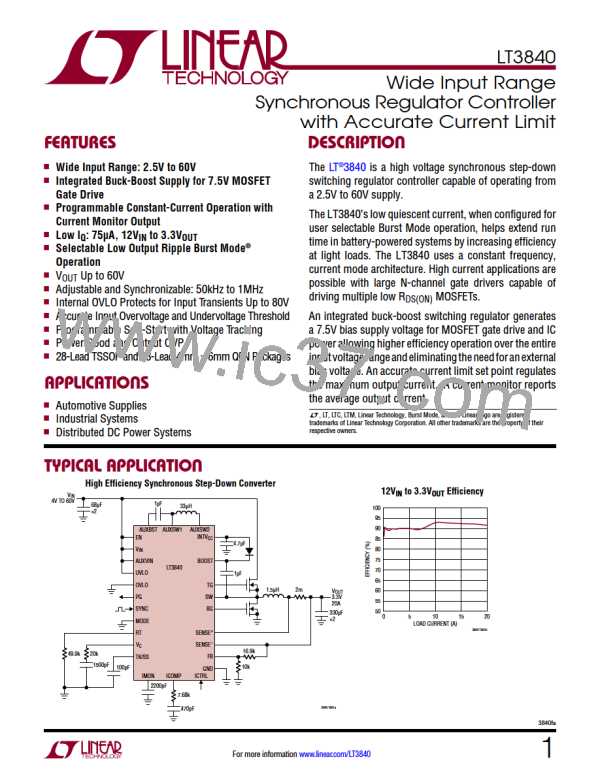LT3840
applicaTions inForMaTion
Switching Frequency
Inductor Selection
The choice of switching frequency is a trade-off between
converter efficiency and component size. Low frequency
operation improves efficiency by reducing MOSFET
switching losses and gate charge losses. However, lower
frequency operation requires more inductance for a given
amount of ripple current, resulting in larger inductor size.
Increasing the ripple current requires additional output
capacitance to maintain the same output ripple voltage.
The critical parameters for the selection of an inductor
are minimum inductance value, saturation current and
RMS current. For a given ΔI , the inductance value is
L
calculated as follows:
VIN(MAX) – VOUT
L≥ VOUT
•
f
•VIN(MAX) •ΔI
L
SW
The typical range of values for ΔI is (0.2 • I
) to
OUT(MAX)
L
For converters with extremely high or low step-down V
IN
(0.5 • I
), where I
is the maximum load
OUT(MAX)
OUT(MAX)
to V
ratios, another consideration is the minimum
OUT
current of the supply. Using ΔI = 0.3 • I
yields a
OUT(MAX)
L
on and off times of the LT3840. A final consideration for
operating frequency is in noise-sensitive systems where
it is often desirable to keep the switching noise out of a
sensitive frequency band.
good design compromise between inductor performance
versusinductorsizeandcost.AvalueofΔI =0.3•I
L
OUT(MAX)
producesa 15%ofI
ripplecurrentaroundtheDC
OUT(MAX)
output current of the supply. Lower values of ΔI require
L
The LT3840 uses a constant frequency architecture pro-
larger and more costly magnetics. Higher values of ΔI
L
grammablewithasingleresistor(R )overa50kHzto1MHz
will increase the peak currents, requiring more filtering
T
range. The value of R for a given operating frequency can
on the input and output of the supply. If ΔI is too high,
T
L
be chosen from Table 1 or from the following equation:
the slope compensation circuit is ineffective and current
mode instability may occur at duty cycles greater than
50%. To satisfy slope compensation requirements the
minimum inductance is calculated as follows:
4
(–1.08)
R (kΩ) = 2.32 • 10 • f
T
SW
Table 1. Recommended 1% Standard Values
R (kΩ)
f
SW
(kHz)
2DCMAX –1 RSENSE •30
T
L
> VOUT
•
•
MIN
348
158
50
DCMAX
f
SW
100
200
300
400
500
600
700
800
900
1000
76.8
49.9
36.5
28.0
23.2
19.1
16.5
14.3
13.7
Magneticsvendorsspecifythesaturationcurrent,theRMS
current or both. When selecting an inductor based on
inductor saturation current, use the peak current through
the inductor, I
+ ΔI /2. The inductor saturation
OUT(MAX)
L
currentspecificationisthecurrentatwhichtheinductance,
measuredatzerocurrent,decreasesbyaspecifiedamount,
typically 30%. When selecting an inductor based on RMS
currentrating,usetheaveragecurrentthroughtheinductor,
I
.TheRMScurrentspecificationistheRMScurrent
OUT(MAX)
at which the part has a specific temperature rise, typically
40°C, above 25°C ambient. After calculating the minimum
inductance value, the saturation current and the RMS
current for your design, select an off-the-shelf inductor.
Contact the Applications Group at Linear Technology for
furthersupport.Formoredetailedinformationonselecting
an inductor, please see the Inductor Selection section of
Linear Technology Application Note 44.
3840fa
14
For more information www.linear.com/LT3840

 Linear [ Linear ]
Linear [ Linear ]